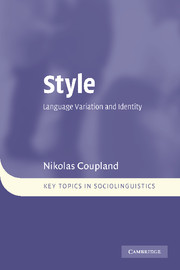Book contents
- Frontmatter
- Contents
- List of figures and tables
- Preface and acknowledgements
- Transcription conventions
- 1 Introduction
- 2 Style and meaning in sociolinguistic structure
- 3 Style for audiences
- 4 Sociolinguistic resources for styling
- 5 Styling social identities
- 6 High performance and identity stylisation
- 7 Coda: Style and social reality
- References
- Index
1 - Introduction
Published online by Cambridge University Press: 14 May 2010
- Frontmatter
- Contents
- List of figures and tables
- Preface and acknowledgements
- Transcription conventions
- 1 Introduction
- 2 Style and meaning in sociolinguistic structure
- 3 Style for audiences
- 4 Sociolinguistic resources for styling
- 5 Styling social identities
- 6 High performance and identity stylisation
- 7 Coda: Style and social reality
- References
- Index
Summary
LOCATING ‘STYLE’
‘Style’ refers to a way of doing something. Think of architectural styles and the striking rustic style of house-building in rural Sweden. That particular style – what allows us to call it a style – is an assemblage of design choices. It involves the use of timber frames, a distinctively tiered roofline, a red cedar wood stain and so on. We can place this style. It belongs somewhere, even if the style is lifted out of its home territory and used somewhere else. It has a social meaning. The same is true for styles in all other life-domains. Cultural resonances of time, place and people attach to styles of dress and personal appearance in general, to styles in the making of material goods, to styles of social and institutional practice, perhaps even to styles of thinking. We could use David Machin and Theo van Leeuwen's (2005) idea of ‘social style’ to cover all these. The world is full of social styles.
Part of our social competence is being able to understand these indexical links – how a style marks out or indexes a social difference – and to read their meanings. The irony is that, if we ourselves are closely embedded in a particular social style, we may not recognise that style's distinctiveness. Reading the meaning of a style is inherently a contrastive exercise. You have to find those red cedar buildings ‘different’ in order to see them as having some stylistic significance.
- Type
- Chapter
- Information
- StyleLanguage Variation and Identity, pp. 1 - 31Publisher: Cambridge University PressPrint publication year: 2007

